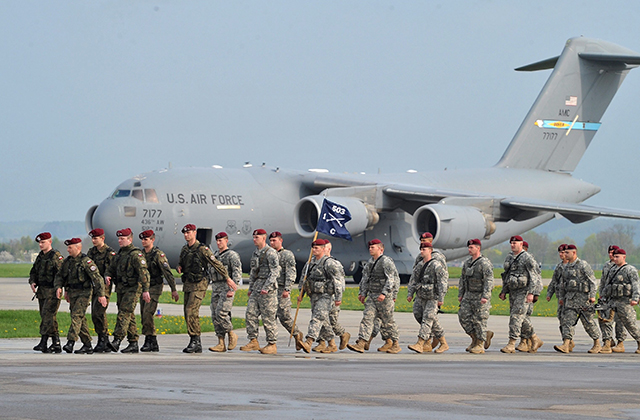U.S. Soldiers to the Baltics: A Good First Step
Luke Coffey /

Polish soldiers (L) accompany US Airborne soldiers upon their arrival at the military airport in Swidwin, northern Poland, 23 April 2014. An US Army company of about 150 soldiers from the 173rd Airborne Brigade Combat Team based in Vicenza, Italy, came for military exercises in Poland due to the political situation in Ukraine. The exercises, involving some 600 troops, also take place in Estonia, Latvia and Lithuania, and is scheduled to last for about a month. (Photo: MARCIN BIELECKI/EPA/Newscom)
The recent announcement that 600 U.S. soldiers from the Italy-based 173rd Airborne Brigade will be sent to the three Baltic states of Latvia, Lithuania and Estonia, as well as Poland, for training exercises is a step in the right direction. While these deployments are symbolically important, the U.S. needs to do more to reassure its allies and deter Russian aggression.
In addition to the 600 soldiers, the U.S. has already sent 12 F-16 fighter jets and 200 support personnel to Poland and an additional six F-15s to Lithuania. If this doesn’t seem like a lot, well, that’s because it isn’t.
These recent deployments demonstrate two important points:
First, U.S. forces in Europe are as important today as they were during the Cold War. Those who are calling for the return of U.S. forces from Europe fail to understand the economic and security interests the U.S. has in the region. Military forces in Europe give policy makers options and allow them to respond to crisis in a timely manner. The 600 troops going to the Baltics and Poland are deploying from U.S. bases in Italy. The additional F-15s and F-16s (which includes their crews, maintenance staff, fuel, spare parts, etc) deployed to Eastern Europe from U.S. air bases in England and Italy respectively. Without this forward presence in Europe these deployments would have been costlier and would have taken longer.
Second, the modest size and scope of these deployments demonstrates how empty the cupboard is in Europe. Since 2012 two armored brigades and an A-10 squadron, totaling almost 10,000 U.S. troops, have been removed from Europe. Other than a few left for training purposes, there isn’t a U.S. main battle tank than can be used for combat operations in Europe for the first time in 70 years.
After years of showing little interest in transatlantic relations, the administration is now playing catch up. Last October, long before Russia made its land grab in Crimea and ratcheted up its bellicosity in central and eastern Europe, The Heritage Foundation published a report listing 22 steps the U.S. could take to improve Baltic security including:
- Establish a permanent military presence in the Baltic region;
- Consider using the Baltic states as part of its global prepositioning program for military hardware;
- Establish a Baltic Sea Rotation Force modeled off of the U.S. Marine Corps rotational forces in the Black Sea; and
- Prioritize U.S. training missions in the Baltic region over others in Europe to ensure that defense cuts and sequestration do not impact U.S.–Baltic relations.
The U.S. needs a strategy for dealing with Russia; it can’t just react. Deploying piecemeal U.S. forces to the region is unlikely to deter Russian aggression or reassure America’s NATO allies.
Any response that NATO makes to reinforce its members’ territorial integrity would be a responsible defensive measure—one designed not to liberate the Crimea or provoke a war with Russia, but to defend the alliance. It makes—sense from a military and diplomatic point of view—to have robust capability in central and eastern Europe. After all, it will be far easier deterring Russia and defending the Baltics than it will be liberating them.
Friend and foe alike in the region will be watching America’s actions in the coming weeks closely.
